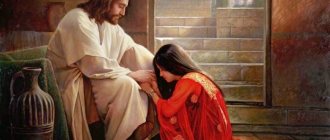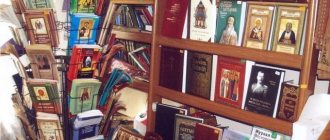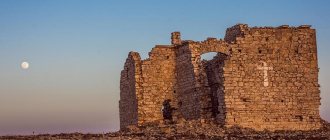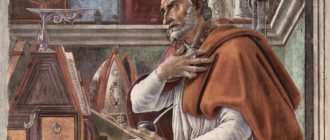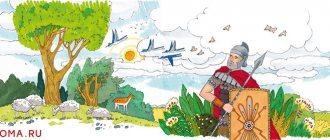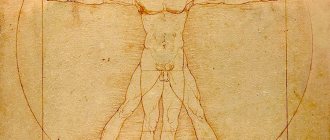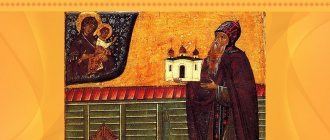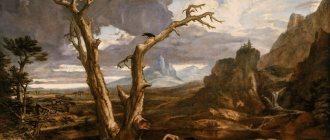Preliminary information
Biographical information about the childhood and youth of St. John Cassian the Roman is extremely limited. Neither the place nor the exact date of his birth is known.
According to the most common opinion, the birthplace of John Cassian was Scythia Minor (a Roman province; now the territory of Romania). The approximate time of birth is considered to be the period from 360 to 365 years.
We do not know with certainty when and from whom he received the name John. According to one version, it was given to him at baptism, according to another, when he was tonsured a monk. But there is reason to believe that he took this name for himself, in honor of his teacher and bishop, St. John Chrysostom.
John Cassian came from a pious, fairly wealthy family. The basic rules of faith and Christian morality were instilled in him from childhood.
In due time, he received a comprehensive education of the classical type, studied philosophy, ancient poetry, astronomy, and rhetoric well. In addition to Latin, he spoke Greek.
Over time, John’s spiritual education, diligence and personal talents bore fruit: he preferred the path of humble monastic life to the career of a secular husband that opened before him.
The fight against passions is the basis of the teaching of St. John Xsian the Roman
The Monk John Cassian the Roman left behind a great theological legacy. The basis of his teaching is the fight against human passions. Among them he named the following:
- gluttony;
- fornication;
- love of money;
- anger;
- sadness;
- despondency;
- vanity and pride.
In addition to describing these passions, the saint also gave his advice on how to combat them. For example, he advised those who were easily angry to direct their anger at the passion itself, and not at the objects and people around them. This allows you to channel your anger in the right direction, making it salutary.
John Cassian the Roman called to fight 8 human passions.
The saint advised fighting against fornication with the help of not only prayer and fasting, but also physical labor. He called the reason for the love of money a lack of love for God, as well as lethargy and relaxation of the spirit.
At the same time, he noted that the love of money, like any passion, develops gradually: once you become attached to one denarius, you can become completely mired in sin.
Video: At the 3rd minute, the author says that St. John Cassian the Roman argued that the cause of human suffering is passion.
As an experienced monk, Cassian said that one can only be cured of despondency through work. That is why, the saint said, the Egyptian fathers did not allow the monks to be idle for even a minute. Pride, in his opinion, is found “everywhere and in everything.”
Monasticism
Around 380, John Cassian the Roman undertook a pilgrimage to Palestine. During the pilgrimage, he was accompanied by his longtime friend, Herman.
Here, on sacred land, the friends decided to renounce the temptations of a vain life in the world and, having received the necessary blessing, entered the Bethlehem monastery. There is an opinion that this monastery was located on the Field of the Shepherds.
While in the monastery, the friends indulged in prayer, listened to sermons, performed obedience, and observed fasts. The time came and they, having made the proper vows, took on monastic robes.
Having mastered the rudiments of ascetic experience over the years of hard work, they wanted to learn more about asceticism, strengthen their feats, and they thought of going to the homeland of monasticism, Egypt.
Egyptian period
Having prayed properly before the road, asking for blessings and promising the abbot to return to the monastery, the friends set off on the road. The path was not easy, but God was there to help them.
By sea they traveled by ship to the port of Tanis, and from there, accompanied by Bishop Archebius, they reached Panefis. There was the monastery of the famous Abba Pinufius. The Lord brought them together with the monks who lived and worked among the salt lakes, on the local hills, with Abba Nestor, Heremon, as well as with Abba Pinuphius, who lived near the monastery in a cell.
Having stayed in Panefis for some time, John and Herman, having given thanks to God, moved on and arrived in the city of Diolkos. Here they drew wisdom by communicating with the fathers: Archebius, John, Piammon and others.
The Skete desert was chosen as the next pilgrimage point. In the 4th century it was inhabited by many pious hermits.
Visiting the ascetics there, friends participated in joint prayers, were interested in various ascetic exercises, asked questions, sought advice, and listened to soul-helping exhortations.
They were lucky enough to communicate with spiritually mature fathers: Paphnutius, Moses, Isaac, Serapion, Theona, Daniel.
Soon John and Herman joined the community, which was under the leadership of Abba Paphnutius. This Abba was an Origenist monk who served as a presbyter in one of the churches of the Skete. On Saturdays and Sundays the temple was filled with hermits gathering for worship. While staying in the Skete, John Cassian the Roman exhausted his body with fasting and physical labor, and prayed a lot and sincerely.
It is stated that during this period he and Herman visited the desert of Kellia, located approximately 80 miles from Scete. There friends saw Abba Theodore.
After seven years of incessant ascetic work in Egypt, John went to Palestine, and again together with Herman. The friends wanted to fulfill the promise made to the abbot of the Bethlehem monastery, who blessed them for the pilgrimage when they were still preparing to travel through Egypt.
Meanwhile, they did not remain in Bethlehem for long and, by the Providence of God, soon returned to Egypt again.
Researchers estimate the total time of John Cassian's stay in Egypt to be ten years. During this time, he grew in spiritual age, acquired invaluable ascetic experience, acquired wisdom, and collected material for future writings.
John Cassian the Roman
Christian monk. Theologian. One of the founders of monasticism in Gaul. Prominent theorist of monastic life. Author of “On the Rules of Cenobitic Monasteries” and “Interviews.” In the Russian Orthodox Church he is venerated as a saint. The memory takes place on March 13.
John Cassian the Roman was born around 360 in Romania. He came from a pious, fairly wealthy family. The basic rules of faith and Christian morality were instilled in him from childhood. In due time he received a comprehensive education of the classical type, studied philosophy, ancient poetry, astronomy, and rhetoric well. In addition to Latin, he spoke Greek.
Over time, John’s spiritual education, diligence and personal talents bore fruit: he preferred the path of humble monastic life to the career of a secular husband that opened before him. Around 380 he made a pilgrimage to Palestine. During the pilgrimage, he was accompanied by his longtime friend, Herman.
Here, on sacred land, the friends decided to renounce the temptations of a vain life in the world and, having received the necessary blessing, entered the Bethlehem monastery. While in the monastery, John Cassian indulged in prayer, listened to sermons, performed obedience, and observed fasts. The time came and, having made the proper vows, he took on the monastic habit.
Having mastered the rudiments of ascetic experience over the years of hard work, John and his friend Herman wanted to learn more about asceticism, strengthen their feats, and thought of going to the homeland of monasticism, Egypt.
Having prayed properly before the road, asking for blessings and promising the abbot to return to the monastery, the friends set off on the road. By sea they reached the port of Tanis by ship, and from there, accompanied by Bishop Archebius, they reached Panefis. There was the monastery of the famous Abba Pinufius. The Lord brought them together with the monks who lived and worked among the salt lakes, on the local hills, with Abba Nestor, Heremon, as well as with Abba Pinufius, who lived near the monastery in a cell.
Having stayed in Panefis for some time, John and Herman, having given thanks to God, moved on and arrived in the city of Diolkos. Here they gained wisdom by communicating with the fathers: Archebius, John, Piammon and others. The Skete desert was chosen as the next pilgrimage point. In the 4th century it was inhabited by many pious hermits.
Visiting the ascetics there, John Cassian and Germanus participated in joint prayers, were interested in various ascetic exercises, asked questions, sought advice, and listened to soul-helping exhortations. They were lucky enough to communicate with spiritually mature fathers: Paphnutius, Moses, Isaac, Serapion, Theona, Daniel.
Soon John joined the community under the leadership of Abba Paphnutius. This Abba was an Origenist monk and served as a presbyter in one of the churches of the Skete. On Saturdays and Sundays the temple was filled with hermits gathering for worship. While in the Skete, the saint exhausted his body with fasting and physical labor, and prayed a lot and sincerely.
After seven years of incessant ascetic work in Egypt, John Cassian the Roman went to Palestine, and again together with Herman. The friends wanted to fulfill the promise made to the abbot of the Bethlehem monastery, who blessed them for the pilgrimage when they were just preparing for their trip to Egypt.
Meanwhile, the friends did not remain in Bethlehem for long and, by the Providence of God, soon returned to Egypt again. Researchers estimate the total time of John Cassian's stay in Egypt to be ten years. During this time, he grew in spiritual age, acquired invaluable ascetic experience, acquired wisdom, and collected material for future writings.
In 399, unrest arose in Egypt due to criticism of the teachings of the anthropomorphites - heretics who argued that God has features similar to those inherent in the human body. The critical review voiced by Archbishop Theophilus of Alexandria met with approval from the brethren of the community of Abba Paphnutius and, in general, from many hermits.
The heretics, dissatisfied with this course of events, flocked to Alexandria and began to threaten Theophilus. They demanded that he renounce Origenist views, and he listened to them. In 400, Theophilus publicly denounced the false teachings of Origen. The Councils of Alexandria and Nitria, held soon after, officially condemned Origenism.
And so, the Origenist monks were persecuted and driven out of Egypt by both the clergy and the government authorities. Many monks are forced to seek shelter, food and support in other countries. About fifty monks found sympathy in the person of the head of the Church of Constantinople, St. John Chrysostom. Among these fifty arrivals were John Cassian the Roman and Germanus.
In Constantinople, the virtues of their friends were noticed. John was elevated to the rank of deacon. In addition, he was entrusted with the position of committee of the treasury at the cathedral. In turn, Herman was ordained a priest.
When Saint John Chrysostom was unjustly accused of abuses and then expelled from Constantinople, Fathers John Cassian the Roman and Herman went to the West to seek support from the Roman Bishop Innocent I. The clergy of Constantinople provided them with a special message, which they passed on to their destination.
After this, John Cassian remained to serve in Rome, as did his friend, Father Herman. The saint stayed in Rome for about twelve years. It was here that he was ordained a priest, after which he received the position of adviser to the Bishop of Rome. During his stay in Rome, he met the future Pope Leo the Great.
In 415, either striving for solitary contemplation, or because of the invasion of the Goths, the Monk John Cassian the Roman arrived in Marseille, where he became close to the local bishop Proculus. Soon, through his efforts, two monasteries were created: male and female. The men's monastery was headed by the saint himself. Subsequently, this monastery became known as the monastery of St. Victor.
Gradually the monastery multiplied with brethren. The experience of Father John Cassian's stay in Egypt contributed to the good organization of the internal life of the monastery. Over time, his fame as a good spiritual leader spread throughout southern Gaul.
In the 20s of the 5th century, Father John, at the request of local bishops, compiled a set of rules for cenobitic monasteries. In addition, during this period he worked on an equally significant work, “Interviews...”. Around 426, the monk took part in the Semi-Pelagian disputes. As an experienced shepherd and hardworking monk, I could not agree with either the teaching that nullifies the significance of the personal efforts of the ascetic, nor with the opposite extreme - the teaching that minimizes the significance of the role of Divine grace. In this regard, he gently pointed out the inaccuracies made by Blessed Augustine.
At the same time, Father John was busy writing a treatise against the heretic Nestorius, “On the Incarnation of the Lord.” At the end of his life, the monk began to lose physical strength.
The Monk John Cassian the Roman died around 435.
His body was buried in the monastery of St. Victor. Works of John Cassian the Roman
12 books “On the rules of cenobitic monasteries” 24 “Conversations” “On the Incarnation of the Lord, against Nestorius” Statements of John Cassian were included in the collection “Philokalia”
Memory of John Cassian the Roman
In the Orthodox Church he is glorified as a saint, the day of remembrance is celebrated on March 13
Among Catholics, according to the Catholic Encyclopedia, some of his views after his death were condemned as semi-Pelagian, but he himself is unofficially venerated in Marseille and is mentioned as a saint by Pope Urban V
12.03.2020
Constantinople and Roman periods
In 399, unrest arose in Egypt due to criticism of the teachings of the anthropomorphites - heretics who argued that God has features similar to those inherent in the human body.
The critical review of the anthropomorphites, voiced by Archbishop Theophilos of Alexandria, met with approval from the brethren of the community of Abba Paphnutius and, in general, from many hermits.
The heretics, dissatisfied with this course of events, flocked to Alexandria and began to threaten Theophilus. They demanded that he renounce Origenist views, and he listened to them.
In 400, Theophilus publicly denounced the false teachings of Origen. The Councils of Alexandria and Nitria, held soon after, officially condemned Origenism.
And so, the Origenist monks were persecuted and driven out of Egypt by both the clergy and the government authorities. Many monks were forced to seek shelter, food and support in other countries.
About 50 monks found sympathy in the person of the head of the Church of Constantinople, St. John Chrysostom. It is believed that among these fifty arrivals were John Cassian the Roman and Germanus.
In Constantinople, the virtues of their friends were noticed. John was elevated to the rank of deacon. In addition, he was entrusted with the position of committee of the treasury at the cathedral. In turn, Herman was ordained a priest.
When Saint John Chrysostom was unjustly accused of abuses and then expelled from Constantinople, Fathers John Cassian the Roman and Herman went to the West to seek support from the Roman Bishop Innocent I. The clergy of Constantinople provided them with a special message, which they conveyed to their destination.
After this, John Cassian remained to serve in Rome, as did his friend, Father Herman.
Father John stayed in Rome for about 12 years. There is reason to believe that it was here that he was ordained a priest, after which he received the position of adviser to the Bishop of Rome.
During his stay in Rome, John Cassian met the future Pope Leo the Great.
The people did not like Saint Cassian, despite the fact that his life is an example of asceticism
The Orthodox Church glorified John Cassian the Roman as a saint. The Catholic Church condemned some of his views after his death as semi-Peligian. At the same time, Pope Urban V mentioned him as a saint, and in Marseilles Cassian was always revered in this capacity unofficially.
Veneration of the saint in Orthodoxy is established on February 28 (March 13) in non-leap years, and on February 29 (March 13) in leap years.
Venerable John Cassian the Roman. Icon. The people do not like Saint John Cassian the Roman, despite his ascetic and ascetic life. This is due to folk superstitions
Unfortunately, despite the ascetic and ascetic life of Saint Cassian, he earned a bad reputation among the Slavic peoples. This was partly due to the fact that the days of the saint’s memory were transferred to non-leap years, which gave rise to various superstitions and folk signs.
Kasyanov's day was popularly considered a dangerous, demonic day. On this day, people were afraid to go out in order not to get sick or die; they did not work, since it was believed that work would not be carried out.
By leaving a comment, you accept the user agreement
Gallic period
In 415, either seeking solitary contemplation, or because of the invasion of the Goths, the Monk John Cassian the Roman arrived in the city of Massilia (now Marseille) in Southern Gaul, where he became close to the local bishop Proculus.
Soon, through his efforts, two monasteries were created: male and female. The men's monastery was headed by Father John himself. Subsequently, this monastery began to be called the monastery of St. Victor (due to the fact that it was located next to the tomb of this martyr).
Gradually the monastery multiplied with brethren. The experience of Father John Cassian's stay in Egypt contributed to the good organization of the internal life of the monastery.
Over time, his fame as a good spiritual leader crossed the borders of Massilia and spread throughout Southern Galia.
In the 20s of the 5th century, Father John, at the request of local bishops, compiled a set of rules for cenobitic monasteries. In addition, during this period he worked on the equally significant work “Interviews...”.
Around 426, the Venerable Father John took part in the semi-Pelagian debates (in polemics related to the understanding of the role of personal freedom and the role of Divine grace in the matter of salvation).
As an experienced shepherd and hardworking monk, he could not agree with either the teaching that nullified the significance of the personal efforts of the ascetic, nor with the opposite extreme - the teaching that minimized the significance of the role of Divine grace. In this regard, John Cassian the Roman gently pointed out the inaccuracies made by Blessed Augustine.
At the same time, Father John was busy writing a treatise against the heretic Nestorius, “On the Incarnation of the Lord.”
At the end of his life, the Monk John Cassian the Roman began to lose physical strength. The death of the ascetic occurred around 435. His body was buried in the monastery of St. Victor.
Saint Cassian wrote a lot about monasticism
During his life, Saint John Kasan the Roman wrote 12 books “On the rules of cenobitic monasteries” and 24 “Conversations”. Recent works are devoted to conversations with Egyptian abbas (spiritual fathers, teachers) about various concepts of moral Christian teaching.
In 429-430, Saint John wrote the essay “On the Incarnation of the Lord, Against Nestor.” This is a dogmatic treatise written at the request of the future Pope Archdeacon Leo. It is recognized by theologians as one of the earliest writings of the monk against the heresy of Nestorianism.
Philokalia (Moscow, 1905). The sayings of St. John Cassian the Roman are included in the collection “Philocalia” or “Philokalia”, translated into Russian
The writings of John Cassian and his sayings were included in the collection “Philokalia” or “Philokalia”. It contains the writings and sayings of the Church Fathers dating back to the 3rd century AD. This work was translated into Slavic in Russia in 1793 by Paisiy Velichkovsky.
The main works of Saint John Cassian the Roman are devoted to monasticism.
In his writings he often described monastic life. For example, in the “Rule of the Ionic Community” he carefully described the monastic clothing of his time. It consisted of:
- kukulya (bonnet);
- colovia;
- amice;
- maforia (cloak);
- Miloti (leather jacket).
In addition, during the time of John Cassius the Roman, monks also wore a staff and sandals. The saint also describes how a monk, entering the monastic path, renounces everything worldly, including property, and becomes at the disposal of the elder.
During his stay in the monastery, he reads general prayers, including doxology and the singing of psalms. For general prayers, the third, sixth and ninth hours (from sunrise) are chosen. In addition, the Scriptures are also read and the monk participates in common meals. The rest of the time the monks spend doing handicrafts or running errands.
